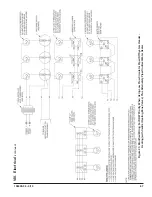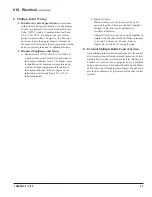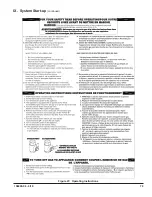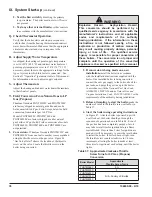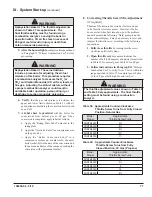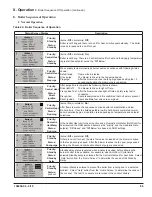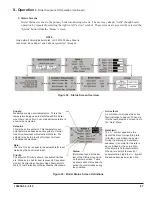
81
106309-03 - 4/19
The peer-peer network is truly “plug and play”.
Communication is activated by simply connecting
a RJ45 ethernet cable between boilers. The Control
provides precise boiler coordination by sequencing
boilers based on both header water temperature and
boiler modulation rate. For example, the lead boiler
can be configured to start a lag boiler after operating
at 50% modulation rate for longer than an adjustable
time. The boilers are modulated in “unison” (parallel)
modulation rate to ensure
even heat distribution.
11. Modbus Communication Interface
A factory configured RS485 Modbus interface is
available for Energy Management System (EMS)
monitoring when not used for Multiple Boiler
Sequencer Peer-To-Peer Network. Consult factory
if this interface must be used in addition to the boiler
Peer-to-Peer Network.
B. Supply Water Temperature Regulation
1. Priority Demand
The Control accepts a call for heat (demand) from
multiple places and responds according to it’s
“Priority”. When more than 1 demand is present the
higher priority demand is used to determine active
boiler settings. For example, when Domestic Hot
Water (DHW) has priority the setpoint, “Diff Above”,
“Diff Below” and pump settings are taken from DHW
selections. Active “Priority” is displayed on the “Boiler
Status” screen
.
X. Operation
B. Supply Water Temperature Regulation (continued)
Table 42: Order of Priority
2. Setpoint Purpose
The Control starts and stops the boiler and modulates
the boiler input from minimum (MBH) to maximum
(MBH) in order to heat water up to the active setpoint.
The setpoint is determined by the priority (Central
Heat or Domestic Hot Water) and as described in the
following paragraphs.
3. Central Heat Setpoint
Upon a Central Heat call for heat the setpoint is either the
user entered Central Heat Setpoint, or is automatically
adjusted by a thermostat’s “Sleep” or “Away” modes
and/or Outdoor Air Reset or, an Energy Management
System (EMS) supplied 4-20mAdc setpoint.
4. Auxiliary Heat Setpoint
Auxiliary Heat is a second heating demand that may
be used to serve either lower temperature radiation
or warmer heat demands such as fan coils. Upon an
Auxiliary Heat call for heat the setpoint is either the
user entered Auxiliary Heat Setpoint or is automatically
adjusted as a thermostat’s “sleep” or, Away Modes or,
Outdoor Air Reset.
5. Outdoor Air Reset
If an outdoor temperature sensor is connected to the
boiler and Outdoor Reset is enabled, the Central Heat
and Auxiliary Heat setpoints will automatically adjusted
downwards as the outdoor temperature increases.
When the water temperature is properly matched to
heating needs there is minimal chance of room air
temperature overshoot. Excessive heat is not sent to the
room heating elements by “overheated” (supply water
temperature maintained too high a setting) water. Reset
control saves energy by reducing room over heating,
reducing boiler temperature & increasing combustion
efficiency and, reducing standby losses as a boiler and
system piping cool down to ambient following room
over heating.
6. Boost Time
When the Central Heat Setpoint is decreased by
Outdoor Air Reset settings the Boost function can
be enabled to increase the setpoint in the event that
central heat demand is not satisfied for longer than
the Boost Time minutes. The Boost feature increases
the operating temperature setpoint by 10°F (5.6°C)
every 20 minutes (field adjustable) the central heat
demand is not satisfied. This process will continue
until heat demand is satisfied (indoor air is at desired
temperature). Once the heat demand is satisfied, the
operating setpoint reverts to the value determined by
the Outdoor Air Reset settings. If Boost Time is zero,
then the boost function is not used.
Priority
Status
Screen
Display
Boiler Responding to:
1st
Sequencer
Control
The boiler is connected to the peer-to-peer
network. The boiler accepts demand from
the Sequencer Master.
2nd
Domestic
Hot Water
DHW call for heat is on and selected
as the priority demand. DHW is always
higher priority than Central Heat. It also
has higher priority than the Sequencer
Control when DHW priority is “enabled”
and “Boiler Piped” IWH is selected.
3rd
Central
Heat
Central Heat call for heat is on and there
is no DHW demand or DHW priority time
has expired.
4th
Auxiliary Heat Auxiliary Heat call for heat is on and there is no
Central Heat or DHW demand. (NOTE: May be
user selected to be higher priority than Central Heat.)
5
th
Frost
Protection
Frost Protection is active and there is no
other call for heat. Frost protection will be
a higher priority than Sequencer Control
if the Sequence Master has no active
call for heat.
6th
Warm
Weather
Shutdown
(WWSD)
WWSD is active and the boiler will not
respond to central heat demands. DHW
demand is not blocked by WWSD.
7
th
Standby
There is no demand detected.
Summary of Contents for Phantom-X Series
Page 49: ...49 106309 03 4 19 VI Water Piping and Trim continued Figure 28 Near Boiler Piping Heating Only...
Page 63: ...63 106309 03 4 19 VIII Electrical continued Figure 40 Ladder Diagram...
Page 64: ...64 106309 03 4 19 VIII Electrical continued Figure 41 Wiring Connections Diagram 2...
Page 73: ...73 106309 03 4 19 IX System Start up continued Figure 47 Operating Instructions...
Page 124: ...124 106309 03 4 19 XIII Service Parts continued...
Page 130: ...130 106309 03 4 19 XIII Service Parts continued...
Page 133: ...133 106309 03 4 19 XIII Service Parts continued 10A 10B 10C 10D 10G...
Page 139: ...139 106309 03 4 19...

